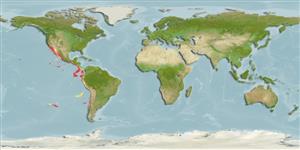Lớp phụ cá toàn đầu (Chimaera) (chimaeras) >
Chimaeriformes (Chimaeras) >
Chimaeridae (Shortnose chimaeras or ratfishes)
Etymology: Hydrolagus: hydro-, combining form of hydor (Gr.), water; lagos (Gr.), hare, i.e., “water rabbit,” probably referring to three pairs of tooth plates, which tend to protrude from the mouth like a rabbit’s incisors. (See ETYFish); melanophasma: melanos (Gr.), black, referring to color in life; phasma (Gr.), ghost or specter, alluding to the vernacular “ghostshark” (literally, a black ghost). (See ETYFish).
Environment: milieu / climate zone / depth range / distribution range
Sinh thái học
Biển Tầng đáy biển sâu; Mức độ sâu 2 - 1720 m (Ref. 93040), usually 565 - 1720 m (Ref. 93040). Subtropical; 35°N - 40°S, 125°W - 70°W (Ref. 93040)
Eastern Pacific Ocean: From Baja California, Mexico to Validivia, Chile.
Bộ gần gũi / Khối lượng (Trọng lượng) / Age
Maturity: Lm ? range ? - ? cm
Max length : 120 cm TL con đực/không giới tính; (Ref. 82286)
Short description
Hình thái học | Sinh trắc học
A species of the genus Hydrolagus based on the absence of an anal fin. Hydrolagus
melanophasma sp. nov. is distinguished from other chimaeroids by a blunt snout with minimal sloping from the orbit to the snout tip, a large slightly curved dorsal fin spine (25.9 % BDL) extending beyond first dorsal fin apex, and a long second dorsal fin (77.3–81.1% BDL) of uniform height throughout. The pectoral fins are large, reaching beyond the pelvic fin insertion when laid flat, trifid claspers forked for 27–27.8% of the total clasper length and the preopercular and oral lateral line canals branch separately or together from the infraorbital canal. Coloration after preservation is a uniform black with no distinct mottling or markings (Ref. 82286).
Life cycle and mating behavior
Chín muồi sinh dục | Sự tái sinh sản | Đẻ trứng | Các trứng | Sự sinh sản | Ấu trùng
James, K.C., D.A. Ebert, D.J. Long and D.A. Didier, 2009. A new species of chimaera, Hydrolagus melanophasma sp. nov. (Chondrichthyes: Chimaeriformes: Chimaeridae), from the eastern North Pacific. Zootaxa 2218:59-68. (Ref. 82286)
IUCN Red List Status (Ref. 130435)
Threat to humans
Harmless
Human uses
Thêm thông tin
Age/SizeSự sinh trưởngLength-weightLength-lengthLength-frequenciesSinh trắc họcHình thái họcẤu trùngSự biến động ấu trùngBổ xungSự phong phúBRUVS
Các tài liệu tham khảoNuôi trồng thủy sảnTổng quan nuôi trồng thủy sảnCác giốngDi truyềnElectrophoresesDi sảnCác bệnhChế biếnNutrientsMass conversion
Các công cụ
Special reports
Download XML
Các nguồn internet
Estimates based on models
Preferred temperature (Ref.
123201): 2.6 - 6.5, mean 3.9 °C (based on 154 cells).
Phylogenetic diversity index (Ref.
82804): PD
50 = 0.5000 [Uniqueness, from 0.5 = low to 2.0 = high].
Bayesian length-weight: a=0.00282 (0.00118 - 0.00673), b=3.10 (2.89 - 3.31), in cm total length, based on LWR estimates for this (Sub)family-body shape (Ref.
93245).
Mức dinh dưỡng (Ref.
69278): 4.0 ±0.6 se; based on size and trophs of closest relatives
Thích nghi nhanh (Ref.
120179): Rất thấp, thời gian nhân đôi của chủng quần tối thiểu là hơn 14 năm (Preliminary K or Fecundity.).
Fishing Vulnerability (Ref.
59153): High to very high vulnerability (72 of 100).
Nutrients (Ref.
124155): Calcium = 17.4 [4.7, 51.6] mg/100g; Iron = 0.615 [0.214, 2.960] mg/100g; Protein = 16.4 [10.7, 19.5] %; Omega3 = 0.285 [0.125, 0.653] g/100g; Selenium = 54.7 [14.2, 174.3] μg/100g; VitaminA = 9.72 [2.86, 35.69] μg/100g; Zinc = 0.566 [0.279, 1.093] mg/100g (wet weight);
